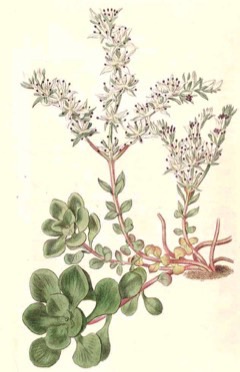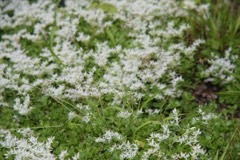 |
|
edibleplants.org |
 |
| David J. Stang wikimedia.org |
Translate this page:
Summary
Physical Characteristics

 Sedum ternatum is an evergreen Perennial growing to 0.2 m (0ft 6in) by 0.3 m (1ft) at a medium rate.
Sedum ternatum is an evergreen Perennial growing to 0.2 m (0ft 6in) by 0.3 m (1ft) at a medium rate.
See above for USDA hardiness. It is hardy to UK zone 4. The flowers are pollinated by Bees, Insects.
It is noted for attracting wildlife.
Suitable for: light (sandy), medium (loamy) and heavy (clay) soils and prefers well-drained soil. Suitable pH: neutral and basic (mildly alkaline) soils and can grow in very alkaline soils.
It can grow in full shade (deep woodland) semi-shade (light woodland) or no shade. It prefers dry or moist soil and can tolerate drought.
UK Hardiness Map
US Hardiness Map
Synonyms
S. deficiens Donn. S. portulacoides Willd. S. ternatum var. minus Praeger
Plant Habitats
Edible Uses
Leaves. Succulent young leaves [1-2].
References More on Edible Uses
Medicinal Uses
Plants For A Future can not take any responsibility for any adverse effects from the use of plants. Always seek advice from a professional before using a plant medicinally.
None known
References More on Medicinal Uses
The Bookshop: Edible Plant Books
Our Latest books on Perennial Plants For Food Forests and Permaculture Gardens in paperback or digital formats.

Edible Tropical Plants
Food Forest Plants for Hotter Conditions: 250+ Plants For Tropical Food Forests & Permaculture Gardens.
More

Edible Temperate Plants
Plants for Your Food Forest: 500 Plants for Temperate Food Forests & Permaculture Gardens.
More

More Books
PFAF have eight books available in paperback and digital formats. Browse the shop for more information.
Shop Now
Other Uses
Ground cover including semi-shade. A good rock gardens plant. Invertebrates shelter: beneficial for insects and other arthropods. Nectary: provides nectar or pollen for beneficial insects [1-2]. The flower nectar and pollen of stonecrops (Sedum spp.) attract various kinds of bees, including Andrena forbesii (Krombein et al., 1979). Less often, wasps and flies visit flowers of these plants. Insects that feed on the foliage of Wild Stonecrop (Sedum ternatum) include the Sedum Aphid (Aphis sedi) and the aphid Aphis acrita. The Eastern Chipmunk eats the roots of this plant (Wrazen & Svendsen, 1978).
Special Uses
References More on Other Uses
Cultivation details
The preference is partial sun to light shade, moist to dry-mesic conditions, and a loamy or rocky soil. Tolerates part shade and moist soils better than most other sedums. Bloom Time: April to May. Bloom Description: White. Flower: Showy. Attracts: Bees, Butterflies. Tolerates rabbit, deer, drought, air pollution.For polyculture design as well as the above-ground architecture (form - tree, shrub etc. and size shown above) information on the habit and root pattern is also useful and given here if available. Evergreen. The plant growth habit is a runner spreading indefinitely by rhizomes or stolons [1-2].
References Carbon Farming Information and Carbon Sequestration Information
Temperature Converter
Type a value in the Celsius field to convert the value to Fahrenheit:
Fahrenheit:
The PFAF Bookshop
Plants For A Future have a number of books available in paperback and digital form. Book titles include Edible Plants, Edible Perennials, Edible Trees,Edible Shrubs, Woodland Gardening, and Temperate Food Forest Plants. Our new book is Food Forest Plants For Hotter Conditions (Tropical and Sub-Tropical).
Shop Now
Plant Propagation
Division, Cuttings. Easy - divide or cut stems and lay on potting soil or place shallowly into the potting soil.
Other Names
If available other names are mentioned here
Three-leaved stone crop
Native Range
NORTHERN AMERICA: United States (Indiana, New Jersey, Ohio, Pennsylvania, West Virginia, Illinois, Iowa (east), Missouri (south), Alabama (north), Arkansas, Delaware, Georgia (north), Kentucky, Maryland, North Carolina, South Carolina (north), Virginia, Mississippi (north), Tennessee)
Weed Potential
Right plant wrong place. We are currently updating this section.
Please note that a plant may be invasive in one area but may not in your area so it's worth checking.
None Known
Conservation Status
IUCN Red List of Threatened Plants Status : Not Listed.

| Related Plants
|
| Latin Name | Common Name | Habit | Height | Hardiness | Growth | Soil | Shade | Moisture | Edible | Medicinal | Other |
| Sedum acre | Common Stonecrop, Goldmoss stonecrop, Gold Moss Sedum | Perennial | 0.1 |
4-9
| F | LMH | N | DM | 1 | 2 | 3 |
| Sedum aizoon | Sedum | Perennial | 0.4 |
4-10
| M | LMH | N | DM | 1 | 1 | |
| Sedum album | Small Houseleek, White stonecrop, Sedum, Stonecrop | Perennial | 0.1 |
6-8
| M | LMH | N | DM | 1 | 1 | 3 |
| Sedum anacampseros | Loce Restorer | Perennial | 0.1 |
5-9
| | LMH | SN | DM | 1 | 0 | 3 |
| Sedum arboroseum | Garden Stonecrop | Perennial | 0.5 |
5-9
| | LMH | SN | DM | 1 | 2 | |
| Sedum divergens | Pacific Stonecrop | Perennial | 0.2 |
5-9
| | LMH | N | DM | 1 | 1 | |
| Sedum forsterianum | Stonecrop | Perennial | 0.2 |
6-9
| | LMH | N | DM | 1 | 0 | |
| Sedum japonicum | | Perennial | 0.2 |
-
| | LMH | N | DM | 1 | 0 | |
| Sedum kamtschaticum | Orange stonecrop, Kamschataka Sedum, Kamschataka Stonecrop | Perennial | 0.1 |
4-10
| M | LMH | N | DM | 1 | 2 | 2 |
| Sedum lanceolatum | Spearleaf Stonecrop, Subalpine stonecrop | Perennial | 0.2 |
5-9
| | LMH | N | DM | 1 | 1 | |
| Sedum lineare | Needle stonecrop | Perennial | 0.3 |
6-9
| | LMH | N | DM | 1 | 1 | |
| Sedum makinoi | Stonecrop, Sedum | Perennial | 0.2 |
8-10
| M | LMH | N | DM | 1 | 2 | |
| Sedum oreganum | Oregon stonecrop | Perennial | 0.2 |
5-9
| | LMH | N | DM | 1 | 0 | 2 |
| Sedum rupestre | Crooked Yellow Stonecrop | Perennial | 0.1 |
6-9
| | LMH | SN | DM | 1 | 0 | 2 |
| Sedum sarmentosum | stringy stonecrop | Perennial | 0.1 |
6-9
| | LMH | N | DM | 1 | 1 | |
| Sedum sediforme | | Perennial | 0.5 |
7-10
| | LMH | N | M | 1 | 0 | |
| Sedum spathulifolium | Broadleaf Stonecrop, Purdy's stonecrop, Yosemite stonecrop, Stonecrop, Blood Leaf Sedum | Perennial | 0.1 |
6-10
| M | LMH | SN | DM | 1 | 1 | 3 |
| Sedum spectabile | Ice Plant | Perennial | 0.4 |
5-9
| | LMH | N | DM | 2 | 1 | 3 |
| Sedum spurium | Caucasian Stonecrop | Perennial | 0.2 |
6-9
| | LMH | N | DM | 1 | 0 | 3 |
| Sedum stenopetalum | Wormleaf Stonecrop | Perennial | 0.2 |
5-9
| | LMH | N | DM | 1 | 1 | |
| Sedum stoloniferum | Stolon stonecrop, Sedum | Perennial | 0.2 |
7-9
| M | LMH | N | DM | 1 | 0 | |
| Sedum telephium | Orpine | Perennial | 0.5 |
4-8
| | LMH | FSN | DM | 1 | 2 | |
|
Growth: S = slow M = medium F = fast. Soil: L = light (sandy) M = medium H = heavy (clay). pH: A = acid N = neutral B = basic (alkaline). Shade: F = full shade S = semi-shade N = no shade. Moisture: D = dry M = Moist We = wet Wa = water.
Now available:
Food Forest Plants for Mediterranean Conditions
350+ Perennial Plants For Mediterranean and Drier Food Forests and Permaculture Gardens.
[Paperback and eBook]
This is the third in Plants For A Future's series of plant guides for food forests tailored to
specific climate zones. Following volumes on temperate and tropical ecosystems, this book focuses
on species suited to Mediterranean conditions—regions with hot, dry summers and cool, wet winters,
often facing the added challenge of climate change.
Read More
Expert comment
Author
Michx.
Botanical References
Links / References
For a list of references used on this page please go here
Readers comment
| Add a comment |
|
If you have important information about this plant that may help other users please add a comment or link below. Only comments or links that are felt to be directly relevant to a plant will be included. If you think a comment/link or information contained on this page is inaccurate or misleading we would welcome your feedback at [email protected]. If you have questions about a plant please use the Forum on this website as we do not have the resources to answer questions ourselves.
* Please note: the comments by website users are not necessarily those held by PFAF and may give misleading or inaccurate information.
To leave a comment please Register or login here All comments need to be approved so will not appear immediately.
|
|